The Hidden Churches of Somerset
by Louise Simmons
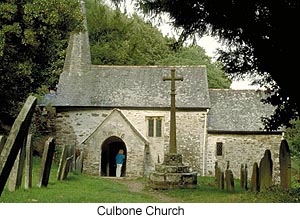 It's hardly surprising that Somerset, that English county famed for both Bath and Glastonbury, is one of the best areas to visit to see a wonderful collection of English churches. But the real treasures are the lesser-known parish churches, still in use hundreds of years after they were first constructed. Leave the tourist trail, and you'll find some of the most marvellous Saxon and medieval architecture and decoration in the country.
It's hardly surprising that Somerset, that English county famed for both Bath and Glastonbury, is one of the best areas to visit to see a wonderful collection of English churches. But the real treasures are the lesser-known parish churches, still in use hundreds of years after they were first constructed. Leave the tourist trail, and you'll find some of the most marvellous Saxon and medieval architecture and decoration in the country.
The best place to start must be at Culbone, on the Somerset coast, which is host to England's smallest church. You'll have to abandon your car and be prepared for a mile-long walk to get there, but that should be no hardship, as you'll be walking through picturesque woodlands, which part only briefly to make room for this tiny Saxon building and its ancient graveyard.
The land round the church was used as a leper colony in the 1540s, and a prison colony at the start of the 18th century. So remote was the area that there was no need to lock anyone up -- prisoners were simply dumped on the coast by ship and left to fend for themselves. Look for the small smiling face carved into the wall of the church.
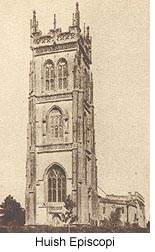 For the greatest concentration of magnificent church towers, Somerset is unbeatable. One design that stands out is that known as the Taunton or Quantock tower. Tall, square towers, built in three distinct stages, are adorned with buttresses, statues, and the local speciality, carved figures known as hunky punks. Three of the best examples are at Huish Episcopi, Isle Abbots and Kingsbury Episcopi, towns about ten miles apart in south Somerset. Slightly further west is Kingston St Mary, which has a slightly shorter tower, but some very interesting, and fairly decidedly non-Christian hunky punks. Hunky punks, unlike gargoyles (which also appear on many of these churches), are purely decorative, and it's well worth a close study of the towers to make sure you spot them all.
For the greatest concentration of magnificent church towers, Somerset is unbeatable. One design that stands out is that known as the Taunton or Quantock tower. Tall, square towers, built in three distinct stages, are adorned with buttresses, statues, and the local speciality, carved figures known as hunky punks. Three of the best examples are at Huish Episcopi, Isle Abbots and Kingsbury Episcopi, towns about ten miles apart in south Somerset. Slightly further west is Kingston St Mary, which has a slightly shorter tower, but some very interesting, and fairly decidedly non-Christian hunky punks. Hunky punks, unlike gargoyles (which also appear on many of these churches), are purely decorative, and it's well worth a close study of the towers to make sure you spot them all.
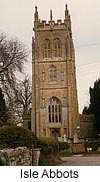 Some of Somerset's other churches aren't so impressive on the outside, but more than make up for it when you get inside. It would be a crime to be in Somerset and not visit St Mary's church at Croscombe. Croscombe itself is a small village with not much to see, although there is a prehistoric earthworks with rather grand name of Maesbury Castle close by. Externally the church is slightly unusual for Somerset in that it has a spire perched above its square tower, but it's the interior that will make you gasp.
Some of Somerset's other churches aren't so impressive on the outside, but more than make up for it when you get inside. It would be a crime to be in Somerset and not visit St Mary's church at Croscombe. Croscombe itself is a small village with not much to see, although there is a prehistoric earthworks with rather grand name of Maesbury Castle close by. Externally the church is slightly unusual for Somerset in that it has a spire perched above its square tower, but it's the interior that will make you gasp.
Although the church itself is medieval, most of the furnishings date from the reign of James I, and comprise some of the most ornate you'll find anywhere. Gifted by the Fortescue family, who lived in the local manor house, are the elaborately carved pews, stalls, desks, the incredibly ornate pulpit, amazing rood screen that separates the nave from the chancel (complete with coat of arms in place of the more common crucifixion scene), and the ceiling. All date from about 1616 (the date is carved into the pulpit) and are in immaculate condition.
Woodwork plays an important part in many other Somerset churches. For impressive carved ceilings, head first for Martock, close to Kingsbury Episcopi, to see the early 16th century oak roof at All Saints. It's made up of six bays in a so-called 'quilted' arrangement, each bay containing 128 individually carved panels. The whole inside of the church is splendid, but the ceiling must be one of the best around.
However, a couple of others in Somerset give All Saints a run for its money in the impressive ceiling competition. Follow the A37 north east for about ten miles to the village of Somerton, once the main town of Somerset. St Michel's ceiling was replaced in about 1500 with a wooden one made up of 640 panels. Beams are carved with faces and angels, and watch how the dragons on the rafters grow in size as you head for the chancel.
Keep heading north east, and you'll get to Shepton Mallet, just beside Croscombe. The Saxon church of St Peter and St Paul not only has an impressive display of gargoyles decorating its exterior and a pulpit carved from a single block of stone (which dates back to about 1530), but also an impressive panelled ceiling. Its 350 individually carved and painted oak panels are attended by angels, and the whole effect is heightened by the fact that the interior is rather narrower than usual.
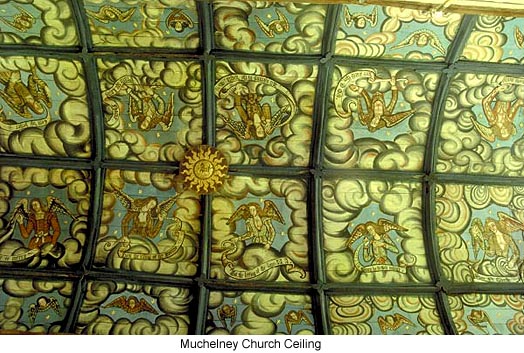 For one last ceiling experience, you should pop in to St Peter and St Paul at Muchelney. On the whole it's not one of Somerset's most impressive churches, but it does have a ceiling of note. Muchelney has a ruined abbey you can visit while you're here, but head into the church first and look up. The wagon ceiling panels were painted in the 17th century, each panel showing an angel. But not the usual celestial image -- some of these ladies are rather scantily dressed, and some even less so: there can't be many churches were you can see topless angels!
For one last ceiling experience, you should pop in to St Peter and St Paul at Muchelney. On the whole it's not one of Somerset's most impressive churches, but it does have a ceiling of note. Muchelney has a ruined abbey you can visit while you're here, but head into the church first and look up. The wagon ceiling panels were painted in the 17th century, each panel showing an angel. But not the usual celestial image -- some of these ladies are rather scantily dressed, and some even less so: there can't be many churches were you can see topless angels!
Take a break from craning your neck at the ceiling, and head for the church at Trull, just a couple of miles south of Taunton. The wooden pulpit, which is believed to be 16th century, is carved with angels and saints and is a lovely piece of work. The ends of the pews, too, are carved with figures, in what seems to be a procession of people following a priest. You should be able to find the section in the north aisle that has the date 1560 and the craftsman's name carved into it.
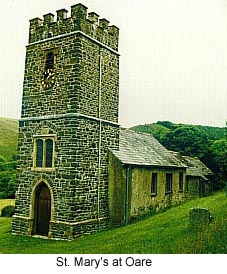 You can find wonderful carvings on the bench-ends at churches at Crowcombe, North Cadbury, Bishop's Lydeard and Brent Knoll, most of which date from the 16th century. Look for the Green Men at Crowcombe. At Bishop's Lydeard, where the benches themselves are carved as well as the uprights, see if you can find the medieval sailing ship. At Brent Knoll, you'll find a series of rather disrespectful carvings showing a fox dressed as a bishop, believed to be directed at an unpopular late-15th century bishop, while nearby East Brent has more traditional carvings of the Annunciation.
You can find wonderful carvings on the bench-ends at churches at Crowcombe, North Cadbury, Bishop's Lydeard and Brent Knoll, most of which date from the 16th century. Look for the Green Men at Crowcombe. At Bishop's Lydeard, where the benches themselves are carved as well as the uprights, see if you can find the medieval sailing ship. At Brent Knoll, you'll find a series of rather disrespectful carvings showing a fox dressed as a bishop, believed to be directed at an unpopular late-15th century bishop, while nearby East Brent has more traditional carvings of the Annunciation.
For sheer pathos, the 19th century monument to three-year-old Isabella Kemeys, which shows the child lying on a pillow holding a broken flower, makes the short detour to Goathurst's St Edward's church worthwhile. If you're a fan of RD Blackmore's Lorna Doone, then you should really visit St Mary's at Oare, the real-life church where the fictional character was killed.
Somerset's more famous religious buildings such as Bath Abbey and the cathedral at Wells should not be missed. They are beautiful sights, wonders of architecture and design. But everyone goes there. Follow the less-trodden roads to the villages no tourists visit, and find some of the hidden wonders of Somerset's religious heritage.
More Information:
We regret that we no longer have the resources to maintain up-to-date links and/or hours and pricing details for the various sites and attractions listed on this website. For more information about the location(s) listed above, please use your favorite search engine or visit Wikipedia.
Louise Simmons is a Scottish freelance writer who lives in a 19th century farmhouse on the top of a hill in the middle of a sheep-farming area of central Scotland. An engineer by profession, after spending many years working in the IT industry in such unusual places as Nigeria, Russia and various oil rigs in the middle of the North Sea, she decided to take up her favourite occupation, writing, on a full-time basis, and currently writes for several online and print magazines. She particularly enjoys researching and writing about the history and culture of British people and places.
Article © 2005 Louise Simmons
Photos: Culbone and Mulcheney courtesy of Britainonview.com; Oare St. Mary's, Isle Abbots and Huish Episcopi courtesy of the Somerset and Dorset Family History Society.
|
